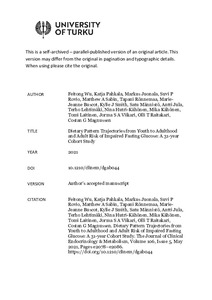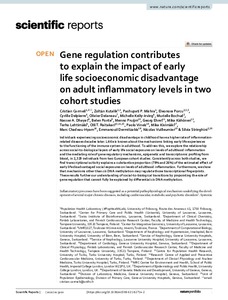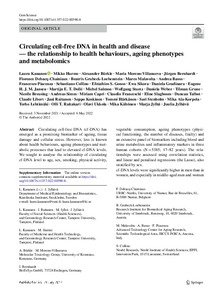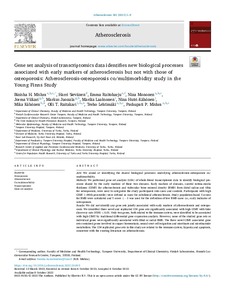Hae
Aineistot 1-10 / 13
Childhood and long-term dietary calcium intake and adult cardiovascular risk in a population with high calcium intake
<p>Background & aims</p><p>The influence of dietary calcium intake in childhood on adult cardiovascular health is unknown, particularly in those with long-term high intake. To examine both linear and non-linear associations ...
Meta-analysis uncovers genome-wide significant variants for rapid kidney function decline
<p>Rapid decline of glomerular filtration rate estimated from creatinine (eGFRcrea) is associated with severe clinical endpoints. In contrast to cross-sectionally assessed eGFRcrea, the genetic basis for rapid eGFRcrea ...
Assessment of plasma ceramides as predictor for subclinical atherosclerosis
<p>Background and aims</p><p>Ceramides have been identified as novel biomarkers for cardiovascular disease (CVD) related events and mortality but their role in etiology of subclinical atherosclerosis is unknown. We aimed ...
Genetic and observational evidence: No independent role for cholesterol efflux over static high-density lipoprotein concentration measures in coronary heart disease risk assessment
<p>Background <br></p><p>Observational findings for high-density lipoprotein (HDL)-mediated cholesterol efflux capacity (HDL-CEC) and coronary heart disease (CHD) appear inconsistent, and knowledge of the genetic architecture ...
Dietary Pattern Trajectories from Youth to Adulthood and Adult Risk of Impaired Fasting Glucose: A 31-year Cohort Study
<p><b>Context</b></p><p>The influence of dietary pattern trajectories from youth to adulthood on adult glucose metabolism is unknown.<br></p><p><b>Objective</b></p><p>To identify dietary pattern trajectories from youth to ...
Gene regulation contributes to explain the impact of early life socioeconomic disadvantage on adult inflammatory levels in two cohort studies
Individuals experiencing socioeconomic disadvantage in childhood have a higher rate of inflammation-related diseases decades later. Little is known about the mechanisms linking early life experiences to the functioning of ...
Circulating cell-free DNA in health and disease - the relationship to health behaviours, ageing phenotypes and metabolomics
<p>Circulating cell-free DNA (cf-DNA) has emerged as a promising biomarker of ageing, tissue damage and cellular stress. However, less is known about health behaviours, ageing phenotypes and metabolic processes that lead ...
Genetic loci and prioritization of genes for kidney function decline derived from a meta-analysis of 62 longitudinal genome-wide association studies
<p>Estimated glomerular filtration rate (eGFR) reflects kidney function. Progressive eGFR-decline can lead to kidney failure, necessitating dialysis or transplantation. Hundreds of loci from genome-wide association studies (GWAS) for eGFR help explain population cross section variability. Since the contribution of these or other loci to eGFR-decline remains largely unknown, we derived GWAS for annual eGFR-decline and meta-analyzed 62 longitudinal studies with eGFR assessed twice over time in all 343,339 individuals and in high-risk groups. We also explored different covariate adjustment. Twelve genome-wide significant independent variants for eGFR-decline unadjusted or adjusted for eGFR-baseline (11 novel, one known for this phenotype), including nine variants robustly associated across models were identified. All loci for eGFR-decline were known for cross-sectional eGFR and thus distinguished a subgroup of eGFR loci. Seven of the nine variants showed variant-by-age interaction on eGFR cross section (further about 350,000 individuals), which linked genetic associations for eGFR-decline with age-dependency of genetic cross-section associations. Clinically important were two to four-fold greater genetic effects on eGFR-decline in high-risk subgroups. Five variants associated also with chronic kidney disease progression mapped to genes with functional in-silico evidence (UMOD, SPATA7, GALNTL5, TPPP). An unfavorable versus favorable nine-variant genetic profile showed increased risk odds ratios of 1.35 for kidney failure (95% confidence intervals 1.03-1.77) and 1.27 for acute kidney injury (95% confidence intervals 1.08-1.50) in over 2000 cases each, with matched controls). Thus, we provide a large data resource, genetic loci, and prioritized genes for kidney function decline, which help inform drug development pipelines revealing important insights into the age-dependency of kidney function genetics.</p>...
Repeatedly Measured Serum Creatinine and Cognitive Performance in Midlife: The Cardiovascular Risk in Young Finns Study
<p><strong>Background and Objectives</strong> Serum creatinine is typically used to assess kidney function. Impaired kidney function and thus high serum creatinine increase the risk of poor cognitive performance. However, ...
Gene set analysis of transcriptomics data identifies new biological processes associated with early markers of atherosclerosis but not with those of osteoporosis: Atherosclerosis-osteoporosis co/multimorbidity study in the Young Finns Study
<p>Aim<br></p><p>We aimed at identifying the shared biological processes underlying atherosclerosis-osteoporosis co/multimorbidity.</p><p>Methods</p><p>We performed gene set analysis (GSA) of whole-blood transcriptomic ...








